The 1951 Red & Blue Back issues (52 cards each) were similar to a deck of
cards and could be used to play a baseball card game. The sets left out
all the game's stars and were not fan favorites keeping Bowman far ahead
in the baseball card market.
In response, Topps issued their "BIGGER is BETTER" 1952 Topps set
they described as: "GIANT IN BOTH SIZE and NUMBER of CARDS" (407).
Series one cards (#1-80) can be found with black or red backs.
The key card in the 1952 Topps set is card #311 MICKEY MANTLE.
It is often called Mickey Mantle's Rookie card but it is not. The honor
goes to his 1951 Bowman card. The 1952 Topps set also featured my
favorite and THE greatest player of all-time, WILLIE MAYS !!!
Again, this is sometimes called Willie Mays' Rookie card but it is not.
That honor also goes to his 1951 Bowman card.
Another 1952 Topps card of note is card #1 Andy Pafko. Pafko, a fine player,
is basically just a "Common card" and should be worth no more than any other
"Common" in the 1952 Topps set - But SURPRIZE !!! It's worth TONS more
because it's card #1 and absorbed much more damage than most cards from
rubber bands and other damage, thus high grade cards are very, very tough
to find accounting for the super high values.
BUT --- That should not account for the super high asking prices on lower
grade copies. THose prices do not make sense (supply and demand).
The 6th (last) series, starts with #311 Mickey Mantle and
ends with #407 Braves Hall-of-Famer Eddie Mathews. These "High Numbers" are
significantly scarcer and can almost be called rare.
In addition to Mickey Mantle, other star High Numbers included
#312 Jackie Robinson and #314 Roy Campanella.
The most common explanation for their scarcity is as follows.
This HUGE set was released in series weeks apart. When it came to the last
series the baseball season was winding down and football was starting.
Most candy store owners had boxes of baseball cards leftover from earlier
in the year so most eliminated their orders for the 6th series of 1952
Topps thus creating the scarcity.
To add interest to the story, it is often said that the unsold 6th series
cards (including THOUSANDS of 1952 Topps MICKEY MANTLEs !!!) were disposed
of by Topps, dumped offshore into the Atlantic Ocean like most of New York's
trash in those days.



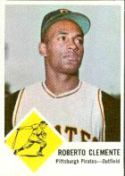
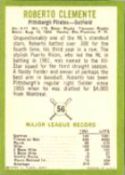

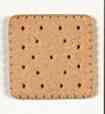 The 1963 Fleer baseball card set planned to be larger but Topps
lawsuit cut it short leaving just 66 cards plus a checklist.
The 1963 Fleer baseball card set planned to be larger but Topps
lawsuit cut it short leaving just 66 cards plus a checklist.  But what 66 cards !!! 1963 Fleer cards are attractive & packed:
also Roberto Clemente, Sandy Koufax ... plus 2 very scare Short Prints.
But what 66 cards !!! 1963 Fleer cards are attractive & packed:
also Roberto Clemente, Sandy Koufax ... plus 2 very scare Short Prints. 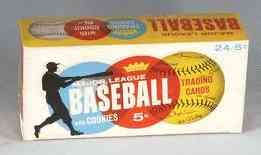 Maury Wills' Rookie card is an interesting story.
In the majors since 1959, quickly became a superstar.
So why 1963 for his rookie ??? Well, back in 1959 Topps deemed
Wills NOT WORTHY enough to be on their baseball cards.
Maury Wills' Rookie card is an interesting story.
In the majors since 1959, quickly became a superstar.
So why 1963 for his rookie ??? Well, back in 1959 Topps deemed
Wills NOT WORTHY enough to be on their baseball cards. 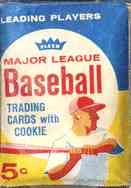 Wills was upset at the slight from Topps. After his 1962 MVP, Topps came
a knocking but he said "NO !". No Topps cards !
Finally, in 1967 came a very scarce hi# Topps card, his first Topps and
also most costly card. Adding interest, he had a 1961 Post Cereal card,
years BEFORE
Wills was upset at the slight from Topps. After his 1962 MVP, Topps came
a knocking but he said "NO !". No Topps cards !
Finally, in 1967 came a very scarce hi# Topps card, his first Topps and
also most costly card. Adding interest, he had a 1961 Post Cereal card,
years BEFORE
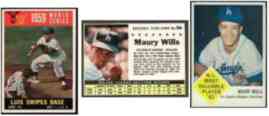 his 'official' rookie. He also photo-bombed a 1960 Topps World Series card,
trying to tag Luis Aparicio at 2nd.
his 'official' rookie. He also photo-bombed a 1960 Topps World Series card,
trying to tag Luis Aparicio at 2nd. 